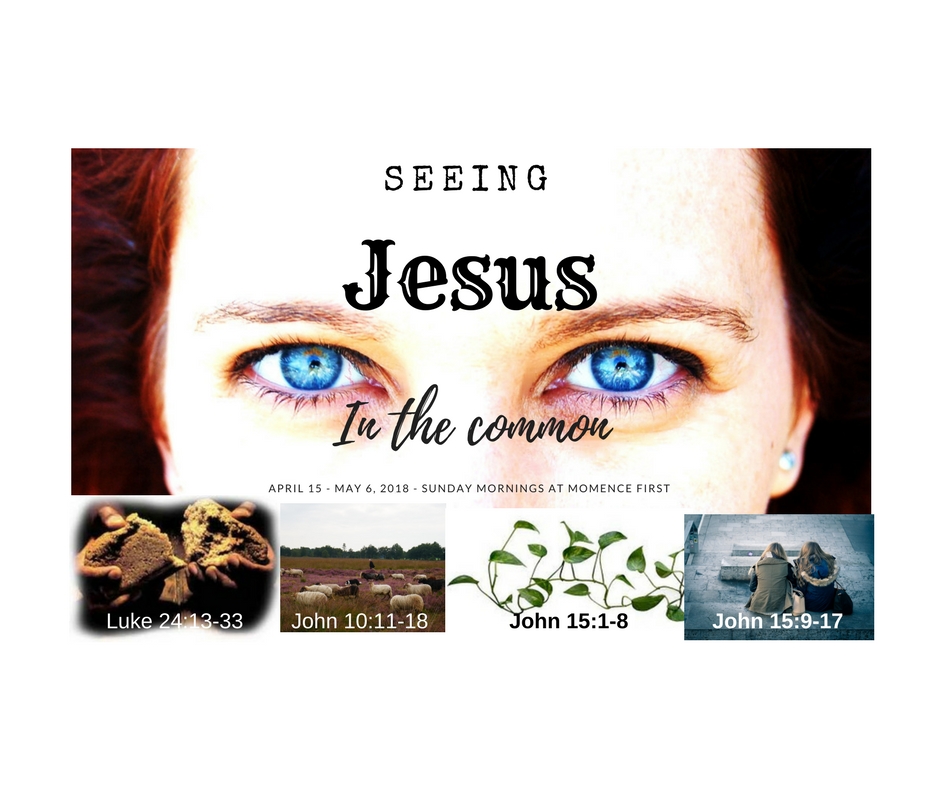Episodes

Sunday Apr 15, 2018
Seeing Jesus in the Broken Bread Luke 24:13-35
Sunday Apr 15, 2018
Sunday Apr 15, 2018
Transcript:
Luke 24:13-35 New International Version (NIV)
Now that same day two of them were going to a village called Emmaus, about seven miles from Jerusalem. They were talking with each other about everything that had happened. As they talked and discussed these things with each other, Jesus himself came up and walked along with them; but they were kept from recognizing him.
He asked them, “What are you discussing together as you walk along?”
They stood still, their faces downcast. One of them, named Cleopas,asked him, “Are you the only one visiting Jerusalem who does not know the things that have happened there in these days?”
“What things?” he asked.
“About Jesus of Nazareth,” they replied. “He was a prophet, powerful in word and deed before God and all the people. The chief priests and our rulers handed him over to be sentenced to death, and they crucified him; but we had hoped that he was the one who was going to redeem Israel. And what is more, it is the third day since all this took place. In addition, some of our women amazed us. They went to the tomb early this morning but didn’t find his body. They came and told us that they had seen a vision of angels, who said he was alive. Then some of our companions went to the tomb and found it just as the women had said, but they did not see Jesus.”
He said to them, “How foolish you are, and how slow to believe all that the prophets have spoken! Did not the Messiah have to suffer these things and then enter his glory?” And beginning with Moses and all the Prophets, he explained to them what was said in all the Scriptures concerning himself.
As they approached the village to which they were going, Jesus continued on as if he were going farther. But they urged him strongly, “Stay with us, for it is nearly evening; the day is almost over.” So he went in to stay with them.
When he was at the table with them, he took bread, gave thanks, broke it and began to give it to them. Then their eyes were opened and they recognized him, and he disappeared from their sight. They asked each other, “Were not our hearts burning within us while he talked with us on the road and opened the Scriptures to us?”
They got up and returned at once to Jerusalem. There they found the Eleven and those with them, assembled together and saying, “It is true! The Lord has risen and has appeared to Simon.” Then the two told what had happened on the way, and how Jesus was recognized by them when he broke the bread.
O God, whose blessed Son made himself known to his
disciples in the breaking of bread: Open the eyes of our faith,
that we may behold him in all his redeeming work; who lives and reigns with you, in the unity of the Holy Spirit, one God,
now and for ever. Amen.
I can practically see them: the travelers trying desperately to figure everything out. Wearily trudging to Emmaus, shoulders hunched, perhaps, feet shuffling, surely. It has been an odd day – Mary Magdalene and some of the others had gone early to the tomb where Jesus had been laid. Peter and John, summoned by their panic at the sight of its awful emptiness raced, too, to the place where he had been and where he was no longer. Angels said strange things – Why do you look for the living among the dead? Could Jesus REALLY be alive? Or were the Jewish leaders playing tricks? It was hard to think of them as having that kind of imagination, but the limits of their own imaginations were being reached – a living Jesus? But then Mary gave them more news later – Jesus had spoken to her! Was she to be believed? Even now, whispered interrogations were being held – Did he really say Peter’s name specifically? What did he look like? It seemed foolish to think her words and the bloody, bruised, dead Rabbi were compatible things. But the alternative explanations were just as strange, just as laden with unthinkable and unspeakable ideas. The two wondered as they walked, uncertainty and maybe a little fear coloring their voices and their demeanor. Another joins them.
It is Jesus. It is the very one they are discussing, but in their fear and confusion and sorrow and even longshot hope of a miracle, they are not seeing him for who he is. He asks them what they are discussing, and I love this moment: they not only tell Jesus everything that has happened, but essentially ask if he’s been living under a rock for the last few days! Perhaps Jesus would have been a little bemused by this, but his words take them to task for not already believing what they’ve been told and for not recognizing all the prophetic moments they have been a part of.
Randal E. Denny writes that then, “Jesus began an exposition of Scripture from each individual prophetic book, giving the first correct lesson on Messianic teachings of the Old Testament. He showed them the golden thread of grace running through the whole fabric of Scripture. It could not be separated from the scarlet thread of atonement. What a sermon that must have been! Jesus opened the Scriptures — developed, illustrated, and applied in himself. How I wish that lesson from the lips of Jesus had been preserved. Someday, in heaven, I hope Jesus will preach that sermon once again!”1
When they arrive at their destination, Jesus feigns leaving them, and they convince him to join them for the evening. They knew something was different about their companion, or at least they enjoyed his company – but still, even after all this conversation and discussion and sermon, they don’t know him.
They sit down to dinner, and it is as Jesus breaks bread that they suddenly realize who he is. As soon as they do, he leaves them. They don’t even finish eating – but run back to Jerusalem. What a different pace they set on the return to Jerusalem! What a different conversation! Their best hope is affirmed, they have had an encounter with the living Christ and it has, as it must always, changed them.
So it is in the ritual of the broken bread that we most clearly see the Jesus we need to see in our doubt, in our uncertainty, in our confusion. The God who raises the dead, the God who walked among us, gave us the simplest tool, the simplest illustration for our thick heads to really see him as he is: two halves of a loaf of a basic food staple. Jesus is visible to us in the commonest and most mundane of moments. I suspect this is why we don’t have the details of that Emmaus road sermon – we don’t need to understand those details the way we need to understand that we can see the risen King most clearly when we shed our sermonizing, strip away our impressive explanations, and simply break bread together. It is in breaking the bread, time and time again, that we see Jesus, and when we do, when we see him clearly in the grace of that moment, Jesus always changes us.


Comments (0)
To leave or reply to comments, please download free Podbean or
No Comments
To leave or reply to comments,
please download free Podbean App.